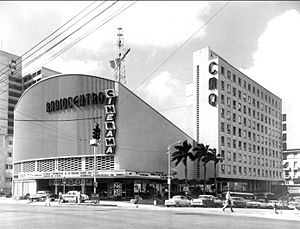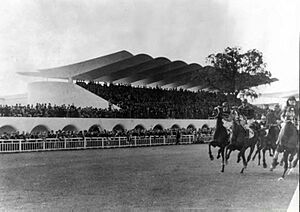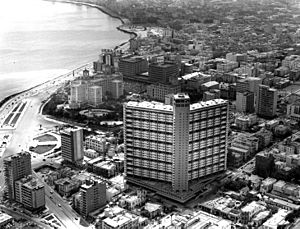Martín Domínguez Esteban facts for kids
Quick facts for kids
Martín Domínguez Esteban
|
|
|---|---|
 |
|
| Born | December 26, 1897 San Sebastián, Spain
|
| Died | September 13, 1970 (aged 72) New York
|
| Nationality | Spanish |
| Alma mater | Universidad Politécnica de Madrid |
| Occupation | Architect |
| Spouse(s) | Josefina Ruz |
| Children | 1 |
| Parent(s) | Concepción Esteban Guerendián and Martín Domínguez Barros |
| Practice | Associated architectural firm[s] |
| Buildings | Hipódromo de la Zarzuela, Radiocentro CMQ Building, FOCSA Building |
Martín Domínguez Esteban (born December 26, 1897, in San Sebastián, Spain – died September 13, 1970, in New York, USA) was a famous Spanish architect. He designed many important buildings in Spain and Cuba. His work helped shape modern architecture in both countries.
Contents
Early Life and Education
Martín Domínguez was born in San Sebastián, Spain. His parents were Concepción Esteban Guerendián and Martín Domínguez Barros. From a young age, around seven years old, he loved to draw. He attended the School of Arts and Offices in San Sebastián at night. During the day, he finished his high school studies.
When he was 17, Martín moved to Madrid. He passed the entrance exam for the Higher School of Architecture. He studied there and graduated in 1924. While in Madrid, he lived at the Residencia de Estudiantes. This was a special place for students from different fields. There, he met many creative people, including the famous writer Federico García Lorca.
Early Career in Spain
After graduating, Martín Domínguez became very active in Madrid's art and intellectual scene. He started working with his friend, architect Carlos Arniches. They worked together on many projects from 1924 until 1936.
One of his first big projects was in 1925. He was asked to redesign the ground floor of the famous Palace Hotel in Madrid. In 1928, he and Carlos Arniches won a competition. They designed several roadside lodges for travelers across Spain. They built 12 of these lodges.
Designing the Hipódromo de la Zarzuela
One of Martín Domínguez's most famous projects in Spain was the Hipódromo de la Zarzuela. This is a horse racing track. The old track in Madrid was torn down to make way for new city development. So, a new one was needed.
Martín Domínguez, Carlos Arniches, and engineer Eduardo Torroja designed the new track. It was built between 1934 and 1936. The roof of the grandstands was very special. It was very thin, only 5 centimeters thick at the ends. This was a big achievement in engineering at the time.
Architectural Ideas
Martín Domínguez was very interested in the ideas of architect Le Corbusier. Le Corbusier visited the Residencia de Estudiantes in 1928. Martín Domínguez talked with him about traditional Spanish buildings. He encouraged Le Corbusier to visit southern Spain.
Martín Domínguez believed that buildings should be honest. They should look like what they are. He thought that how you use and combine building parts was more important than the parts themselves. He cared about society and the environment in his designs. He also valued culture and tradition in modern architecture.
Life in Exile: Cuba
In 1936, the Spanish Civil War began. Martín Domínguez had to leave Spain. He traveled through France and then sailed to Havana, Cuba. He arrived in Cuba in January 1937. In Havana, he married Josefina Ruz, and they had a son named Martín, who also became an architect.
Working in Cuba
From 1938 until 1960, Martín Domínguez worked on many projects in Cuba. He often worked with other Cuban architects because he didn't have his Cuban architect's license. He helped design many social housing projects.
He collaborated with three main architectural teams:
- With Honorato Colete (1938-1943): They designed houses and a theater in Havana.
- With Miguel Gastón and Emilio del Junco (1943-1948): They designed homes, apartment buildings, and important theaters.
- With Miguel Gastón (1948-1952): They worked on city plans and more theaters.
- With Ernesto Gómez Sampera and Mercedes Díaz (1952-1960): This was a very important partnership.

Key Cuban Buildings
With del Junco and Gastón, Martín Domínguez designed the Radiocentro CMQ Building in 1947. This was a very important building in Havana. It was one of the first modern buildings with a "curtain wall" facade. This means the outer walls were made of glass and metal, not solid brick. It was a big step for modern architecture in the city.
His most famous work in Cuba was the FOCSA Building. He designed this with Ernesto Gómez-Sampera and Mercedes Díaz. It was built between 1952 and 1956. The FOCSA Building became the tallest building in Havana, with 39 floors. It was a new type of residential building for its time. They also designed the Ministry of Communications building and many homes for workers.
Second Exile: United States
In 1960, Martín Domínguez had to leave Cuba. He moved to the United States. He became a professor at Cornell University in New York. He taught architecture there for ten years.
While teaching, he traveled a lot. He visited Canada to study new city designs. He also went to South America to advise governments on housing projects. He worked with the Ford Foundation on school designs for the University of Chile. He also helped design a primary school in Rochester, New York.
His work was recognized in 1962 with an exhibition at Cornell University. In 1965, he became a member of The American Institute of Architects (AIA).
Death and Legacy
Martín Domínguez passed away in New York City on September 13, 1970, at the age of 72. He was buried in his hometown of San Sebastián, Spain.
Cornell University held a special ceremony to honor him. In 1978, the university created "The Martin Dominguez Distinguished Teaching Award." This award is given each year to honor his teaching. In 2015, Cornell University also held an exhibition about his life and work. His designs continue to inspire architects today.
See also
 In Spanish: Martín Domínguez Esteban para niños
In Spanish: Martín Domínguez Esteban para niños




